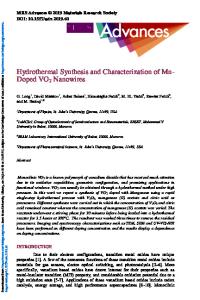Platinum nanoparticle encapsulation during hydrothermal growth of mesoporous oxides: Synthesis, characterization and cat
- PDF / 621,582 Bytes
- 7 Pages / 612 x 792 pts (letter) Page_size
- 86 Downloads / 359 Views
0900-O04-04.1
Platinum nanoparticle encapsulation during hydrothermal growth of mesoporous oxides: Synthesis, characterization and catalytic properties Robert M. Rioux, Hyunjoon Song, James D. Hoefelmeyer, Krisztian Niesz, Michael Grass, Peidong Yang, and G. A. Somorjai Department of Chemistry, University of California, Berkeley, and Materials Sciences Division, Lawrence Berkeley National Laboratory, Berkeley, CA 94720 USA ABSTRACT A synthetic method for the design of heterogeneous catalysts incorporating monodisperse platinum nanoparticles into ordered mesoporous oxide frameworks has been developed. Nanoparticles were synthesized in solution in the presence of surface templating polymer and encapsulated into mesoporous oxide matrices. After polymer removal by calcination, ethylene hydrogenation rates were consistent with previously reported results, while superior activity of low coordination atoms in small crystallites during ethane hydrogenolysis was demonstrated. Changes in reaction selectivity with particle size during the hydrogenation/dehydrogenation of cyclohexene were attributed to a hydrogen coverage effect influencing the hydrogenation pathway and the apparent structure sensitivity of the dehydrogenation pathway. INTRODUCTION There is an interest in catalysis research to develop catalysts capable of near 100% selectivity for the desired product without sacrificing activity [1-2]. We have recently begun a project [3-6] with the aim of producing monodisperse transition metal nanoparticles in the 1-10 nm size range followed by their encapsulation in mesoporous silica [7]. Nanoparticle size is an important variable in the determination of reaction activity but may also be important for reaction selectivity. The influence of particle size on reaction selectivity is appropriately studied on catalytic materials possessing uniform (in size and shape) nanoparticles. A general approach for the design of high surface area catalysts containing monodisperse Pt nanoparticles synthesized in the presence of surface-regulating agents [6] and encapsulated in mesoporous oxide matrices during in-situ hydrothermal growth (Figure I) is demonstrated [7].
Figure 1. Scheme for nanoparticle encapsulation (NE) method.
0900-O04-04.2
Examples of the influence of nanoparticle size on catalytic activity [6, 7] and selectivity [8] for hydrocarbon conversion reactions is presented. EXPERIMENTAL METHODS Synthesis of Pt Nanoparticles Pt particles were synthesized according to literature methods [9, 10]. 1.7 nm Pt particles were made by adding NaOH solution (12.5 mL, 0.5 M) in ethylene glycol (EG) to a solution of dihydrogen hexachloroplatinate (H2PtCl6·6H2O, Alfa Aesar, 250 mg) in 12.5 mL of EG. The mixture was heated at 433 K for 3 h with N2 bubbling. After reaction, particles were precipitated by the addition of 2 M HCl (1 mL), and dispersed in ethanol containing 12.2 mg of poly(vinylpyrrolidone) (PVP, Mw = 29,000). 2.9 nm particles were synthesized by refluxing a mixture of PVP (26.6 mg) and H2PtCl6·6H2O (124.3 mg) in water (40 mL)
Data Loading...











